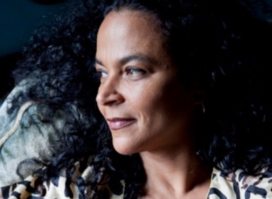Interview: Gabri Christa
 Born and raised in the Caribbean island nation of Curaçao, Gabri Christa has created an impressive body of work for stage and screen. Following her graduation from The School for New Dance Development in the Netherlands, Christa’s career took off in Cuba as a performer and choreographer for the renowned national contemporary dance company Danza Contemporánea de Cuba. She has performed with Bill T. Jones/Arnie Zane Dance Company and DanzAbierta and her own company Danzaisa, which has been produced in the US, Europe, and Latin America and for which she won a Guggenheim Fellowship for Choreography.
Born and raised in the Caribbean island nation of Curaçao, Gabri Christa has created an impressive body of work for stage and screen. Following her graduation from The School for New Dance Development in the Netherlands, Christa’s career took off in Cuba as a performer and choreographer for the renowned national contemporary dance company Danza Contemporánea de Cuba. She has performed with Bill T. Jones/Arnie Zane Dance Company and DanzAbierta and her own company Danzaisa, which has been produced in the US, Europe, and Latin America and for which she won a Guggenheim Fellowship for Choreography.
In 2002, Christa began to explore dance for camera, an experiment that quickly led to a string of award-winning film projects she has produced and directed. Her filmography includes another building project, a series of short narrative dance films, including Quarantine (2007) and Kasita (2014), that take place in and around historic buildings and sites specific to the history of slavery in the Americas. Her 2016 documentary Un Dia Kada Momentu (One Day At A Time) won Best Short Documentary at the Harlem International Film Festival and Best Film at the International Canadian Diversity Film Festival.
Theaterlab in New York City will present the world premiere of Christa’s Magdalena, a deeply personal account of experiencing her Dutch mother’s dementia, and an effort to piece together her mom’s past. The show opens on September 12th.
Works by Women spoke to Gabri Christa about her favorite performance memory, how Magdalena came about and what it’s like teaching the next generation of artists.
WORKS BY WOMEN: How did Magdalena come together? What was the first impulse to create the show from such personal material?
GABRI CHRISTA: I first started writing some of my mom’s story based on some letters she wrote answering questions I asked her. I knew she was losing some of her memory, but I didn’t know she had dementia at that time. I simply wanted to know more. This story first became a screenplay. Since making films can be too expensive, the piece eventually evolved to become a multi-media piece about her.
WBW: Your work touches on how to situate/reconcile personal history with/within/outside the annals of history. In your exploration of these themes, what have you found to be most true, authentic, relevant?
GC: Personal history is authentic, based on what is told and remembered by the person whose story it is. What they remember is based on their own interpretation. Two people seeing the same event never re-tell it the same way, but to each of them, it is authentic and true. When I re-tell a story, it is necessarily an interpretation of a story. In the case of my mother’s World War II experience, her story of being a child in Rotterdam, is easier to place because there is so much information about this part of history which is interwoven with her personal history.

Gabri Christa in Magdalena. Photo by Maria Baranova.
WBW: What has the development process of Magdalena entailed? How have you gotten to this point?
GB: The process includes four years of writing alone. Last summer, I got together with director Erwin Maas to work in the studio and develop the material…just to throw it out and figure out what would be the process. I workshopped it for small audiences, specifically with the idea of having a “living room” conversation about my mom and dementia.
WBW: What first inspired you to be an artist? Where did those first ideas/dreams ignite?
GC: I was a teen in Curaçao when I started writing stories and poetry and making dances (with no training, but yoga) when I met a couple–Felix de Rooy and Norman de Palm, two local artists who had returned to the island to make work. I, for the first time, had an idea of becoming an artist. But it wasn’t until I made a solo piece and another local artist Dolly Beckers told me I was a dancer and should check out modern dance that I checked it out. That was when I moved on a scholarship to the Netherlands to study journalism. The rest is history, but it was all these local amazing people whom I met, took me seriously and encouraged me, including my yoga teacher (who was so authentic), people unapologetically themselves and artists, who inspired me to just follow whatever it was I had to see.
WBW: What’s your most vivid memory from performing? Why does it stand out?
GC: My most amazing performance was performing my new work made for Danza Contemporánea de Cuba, a duet called Grito Verde on that big stage at the Teatro Mella for the most loving audience in Cuba. It was such a journey. I am more of maker though. I love the process better than performing.
WBW: You teach at Barnard. What excites you about teaching and the new generation of artists coming up in the world?
GC: I love teaching for so many reasons. Primarily because the exchange with students is one of those exchanges that always makes me grow as well. I always learn from them. Artists are first and foremost human beings, so my approach is always toward what people as unique individuals bring to the table. Students at Barnard are bright. It’s a liberal arts college; they all will do great things in life, as artists, scientists or whatever their path will be. It’s about the whole human being. I like how artistic practice influences teaching and vice versa.
WBW: What’s the best piece of advice you’ve ever been given?
GC: Follow your heart. I don’t know who gave me that advice though. Of course, my yoga teacher Leo Floridas–his “one day at a time.” It is also the title of the film I made about him.
Magdalena runs September 12 through 22, 2018 at Theaterlab. For more information and tickets, visit Theaterlab’s website.
